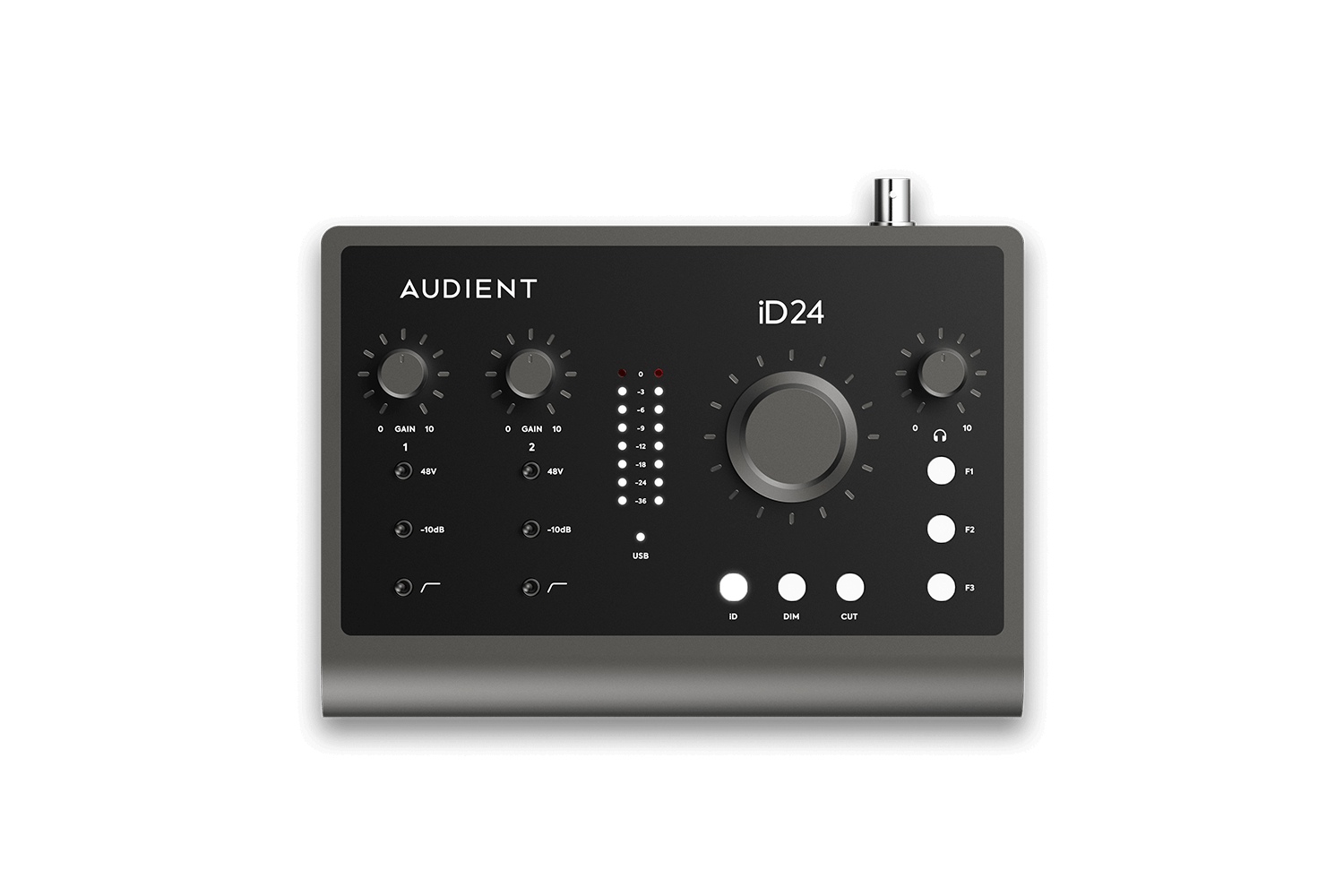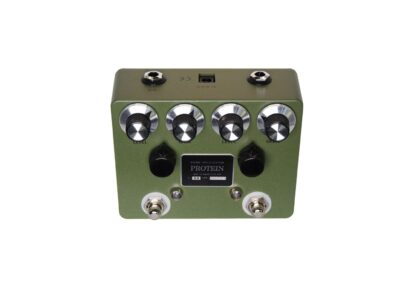Audient iD24 | Studio Connections | Studio Connections | Enquire for pricing
The Audient iD24 is the new replacement for the popular iD22. It features a modern, sleek, compact look, and heralds a new level of performance and quality from the Audient line. The stylish dark ‘smoke grey’ metal chassis complete with hand-milled aluminium knobs, matches the more recent releases from the brand – the switches being illuminated.
Read more gear reviews here.
At a competitive price point, the Audient iD24 has a slew of features, including: Bus-powered recording at 24bit/96kHz (with the ADAT in/out being limited to four channels at 96kHz) and two preamps with a respectable max gain of 58dB. These preamps can be found in the Audient ASP series of preamps and consoles. Each preamp has a balanced XLR input, and there is one JFET instrument Direct Input found on the front. Each channel comes with individual phantom power, a -10dB pad, a High Pass Filter which attenuates the low frequencies by -12dB per octave starting at 75Hz and a phase flipping switch (however this is software controlled rather than hardware as on the iD22). Both channels can be monitored through the headphone output. The Interface features ADAT In and Out, Wordclock Out and a send + return per channel.
In terms of outputs, the Audient iD24 features ADAT out, Two pairs of Line Outputs to send to two pairs of monitors, the headphone monitor parallel output and the USB 2.0 which also functions as the power supply. It is worth noting that the parallel headphone outputs cannot receive separate mixes or levels, but it is a minor price to pay to keep the cost low and the size of the unit small. A small further note on the USB 2.0 connection, it is bus powered, so no external power is needed, and despite being USB 2.0 speed (which is normal for most interfaces) it is a USB C connector which increased its useability and future proofing.
I used the iD24 in the studio for a while and was immediately impressed with how clean the preamps are, and I found it did have enough gain to handle really low input microphones without introducing an obscene amount of noise. Additionally, the software supplied has loosened up a little bit on where the microphone allocations can come from allowing a talkback to come from a USB mic, a built in microphone, or even a webcam so you don’t lose an input having a talkback mic, however the software, despite getting a cool new facelift is slightly clunky to use, especially navigating around when you are using digital ins and outs, there are another few issue others have noticed with the software usability, but these are easily fixable in a future patch or update.
I enjoyed using the send and return inserts on the analogue channels, as it allowed me to use my outboard gear, without the need of an external patch bay prior to the interface. More on the inserts – they can be switched between full, normal and half normal in the software, which adds a whole suite of characteristics. Let me break down the differences, and how I used them in the studio.
In full normal, the send and return are isolated from each other. Basically, what this means is that the processing you do via the outboard gear is inserted back into the signal chain without affecting the original signal. This is useful when you want to use the outboard gear in parallel with the original signal, or when you need to be able to bypass the external signal. I used this mode for recording mastering processing, where I did not want to affect the original track, but wanted a processed return.
In half normal mode, the send is still isolated from the return, but the original signal also gets passed along to the return jack, meaning that the outboard processor is inserted, but the original signal is still present in the return signal. I used this primarily for my outboard compressors, as it allowed me to have analogue parallel compression at the DAW.
The software supplied with the Audient iD24 greatly increases the useability of the interface in many ways, that I will extrapolate on further below.
The Audient iD24 is equipped with Audio Loop-back, allowing the user to quickly transform the iD24 into a multi purpose powerhouse. Loop-back gives you the ability to capture playback from multiple sources on your computer at the same time as the microphone, which can be used to create custom audio feeds perfectly tailored for streaming software. It is a feature perfect for content creators, podcasters, and streamers, all of which can utilise it through the Audient Software Mixer app.
The Audient iD24 comes with a starter version of Cubase along with a few software instruments, an amp simulator and a trial of Sonarworks, which is a godsend for us poor suckers with square rooms and average drivers.
The software instruments included are Retrologue 2 (a classic analogue synth emulation by Steinberg), Waldorf Edition 2 LE (software emulations of classic Waldorf products), M-Tron Select (a digital Mellotron emulation from Gforce), and lastly Torpedo Wall of Sound (an highly realistic amp sim by Two Notes).
The best way to end up with a great sounding piece of audio, is to start at the start, and record the original audio in the highest quality, and the capability to do that consistently and easily is present and abundant in the Audient iD24. Audient iD24 absolutely smashed it out of the park with the new evolution of the already wildly popular iD22.
For more information, head to Audient. For local enquiries, head to Studio Connections.

